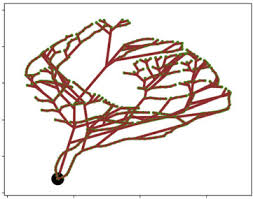I completed my PhD at the Salk Institute at UCSD, under the supervision of Dr. Saket Navlakha. My research focuses on the emerging field of biological distributed algorithms. Nature is abound with examples of biological systems, such as insect colonies, networks of neurons, slime molds, and bacteria swarms, that manage to overcome environmental obstacles and challenges in a distributed manner. Rather than relying on a centralized processor to direct control flow, the systems use limited local communication to produce complex collective behavior. Not only are these systems quite elegant in their emergent properties; the challenges they overcome often have direct analogues to problems in computer science and combinatorial optimization. How do these systems succeed under limited constraints? It is often said that necessity is the mother of invention. Biological systems without the luxury of central control have had the opportunity to innovate and refine methods on evolutionary time-scales. It thus stands to reason that if we can understand how these systems behave, we will arrive at a new, and perhaps improved, understanding of distributed computing. My research seeks to understand how these systems operate, and reverse-engineer efficient distributed optimization algorithms. To this point I have focused on three particular systems: ant colonies, individual neural arbors, and tomato plant root architectures.

Unlike the terrestrial ants that invade your kitchen, Cephalotes, colloquially known as “turtle ants”, are an arboreal ant genus - that is, they nest and forage in trees. The available foraging paths are constrained by the overlapping branches, vines, and junctions in the vegetation. This makes their foraging directly analogous to pathfinding and other optimization problems in discrete graphs. In my research I seek to understand the behavior of turtle ants from an algorithmic perspective. My research, in collaboration with Dr. Deborah Gordon, focuses on the following questions:

Many biological systems depend on transporting resources between a central hub and several peripheral locations. Such systems can be seen as transport networks rooted at the central hub: the hub and peripheral locations represent nodes and the connective material represents edges. These transport networks must balance trade-offs between wiring cost (conserving the material needed to construct the network) and conduction delay (minimizing the time need to transport resources across the network). My research studies how biological networks optimize trade-offs between these competing objectives through the following questions.
Since 2023, I have served as a co-chair of Workshop on Biological Distributed Algorithms (BDA). This annual(-ish) workshop, which takes place in conjunction with the Principles of Distributed Computing (PODC) conference, brings together the community of researchers who study the interface between systems biology and distributed computing algorithms. BDA 2025 will take place on Monday, June 16th at in Huatulco, Mexico.
More accurately, a list of people who have done all of the work to make me look good.